Africa/Middle / Global
Africa/Middle
Briefing
A pan-Middle Eastern science venture, a Lebanese brain drain and an oil boost from Namibia.
In the name of science
Jordan — RESEARCH CENTRE
A Pakistani, an Israeli and an Iranian are meeting in a scientific facility outside the Jordanian capital Amman. That’s not the beginning of a joke, but will soon be a reality for a handful of top scientists from the Middle East. Scheduled for 2015, the Sesame facility (currently under construction) will be the region’s first major international research centre. It is a joint project by nine countries – Bahrain, Cyprus, Egypt, Iran, Israel, Jordan, Pakistan, the Palestinian Authority and Turkey – whose governments are all contributing to the project’s budget.
The Sesame centre is named after the 40m diameter particle accelerator – Synchrotron-light for Experimental Science and Applications in the Middle East – that is at the heart of the compound, a unique machine used in many types of scientific research, especially in physics, biology and medicine.
Sesame is inspired by its European predecessor Cern, a particle accelerator installed in Switzerland in the 1950s to promote scientific cooperation among the continent’s long-time rivals. Officials hope that such a facility will motivate young scientists and technologists from across the region to remain local or return if they have emigrated.


Physicist Professor Moshe Deutsch, a former Israeli representative for Sesame, says dealings between scientists from neighbouring countries, including Iran, are remarkably fruitful and constructive. “It is first and foremost a scientific endeavour,” says Deutsch, “but when young scientists from across the region spend a week next to each other, researching and getting to know each other, it will also help eventually in achieving peace.”
We can be mates: other pan-regional research programmes in the Middle East:
EcoOcean:
An educational co-op of scientists that promotes a healthy marine environment in the eastern Mediterranean. There are representatives from Israel, Lebanon, the Palestinian Authority, Turkey, Tunisia, Malta and Greece.Biological pest control:
A cooperation project between Israeli, Jordanian and Palestinian farmers to promote the use of barn owls and kestrels as biological pest control agents in agriculture.Earthquakes:
Israel and Jordan have been conducting joint drills to exercise rescue tactics in case of an earthquake.Middle Eastern environmental programme:
The Arava Institute for Environmental Studies, located in Israel has a student body that includes Jordanians, Palestinians and Israelis.
Brain drain
Lebanon — EDUCATION
A study released by Saint-Joseph University indicates that a quarter of students polled plan to leave the country after graduating, either to find better job opportunities or to pursue post-graduate studies. One of the main reasons they head abroad is the salary gap.
“Their aspirations are not met,” says Choghig Kasparian, the author of the study, who points out women are now leaving in increasing numbers.
Boom time
Namibia — RESOURCES
An estimated 11 billion barrels of oil has been discovered off Namibia’s coast, sparking hopes of an economic boost for southern Africa. In a ministerial briefing to parliament in July, mines and energy minister Isak Katali announced that oil could start flowing as soon as 2015 – potentially good news for a country sorely dependent on a dwindling supply of diamonds and uranium to take the sting out of unemployment, currently more than 51 per cent.
Pretoria-based IHS economist Ronel Oberholzer says that should the oil find live up to its potential, levels of foreign investment to the region would increase and there would be many opportunities for Namibia’s powerhouse neighbour, South Africa. While many South African companies already have a presence across the border, they will face competition from Chinese firms involved in infrastructure projects there. And then there’s the risk of wealth never leaving the pockets of local elites.
Well read
Cape Verde
Cape Verde has been one of the smartest countries at tackling illiteracy. The rate there has plummeted from 60 per cent in 1975 – when the Portuguese-speaking archipelago in West Africa became independent – to a figure of roughly 20 per cent today. So still a way to go.

Q&A
Khalid Benhamou
Director, Sahara Wind
Rabat
Benhamou leads a team of scientists in Rabat looking to turn the gales that blow across the desert into electricity. The aim is to power North African industry and sell the excess to Europe.
What’s so good about Saharan wind?
You have few areas of this size with such consistent wind. A turbine operating in German conditions, for instance, has only half of the productivity possible in the Sahara region.
What’s the next step?
We need to have the region’s main economic players involved with this energy system. We want to ensure that the maximum monetary output is reaped from extracting natural resources by offering industries a steady alternative to the high, fluctuating prices of fossil fuel they currently rely on.
When will we see big wind farms in the Sahara?
A one gigawatt (GW) wind turbine facility in Morocco will be finished by autumn. With the Sahara Wind Project, we’re aiming to complement that programme by creating an additional 5GW for export. Eventually, we want to harness the wind all along this Atlantic coast, from Tarfaya in the south of Morocco right down to Senegal.


